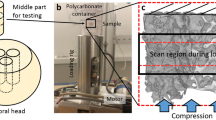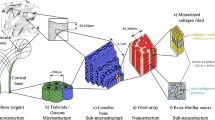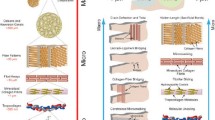Abstract
Although biomedical imaging technology is now readily available, few attempts have been made to expand the capabilities of these systems by adding not only quantitative but also functional analysis tools combining microimaging with time-lapsed mechanical testing. An area of special interest is multiscale functional imaging of trabecular bone to assess the relative importance of bone “quality” in the assessment of the mechanical competence of bone. First, relevant studies dealing with hierarchical imaging of trabecular bone and classic analyses such as quantitative morphometry and finiteelement analysis to predict bone strength are reviewed. Second, studies are presented investigating failure mechanisms of three-dimensional trabecular bone through dynamic, time-lapsed microimaging, including image-guided techniques developed for this purpose and utilizing microcompression. For the first time, these allow the direct three-dimensional visualization and quantification of failure initiation and progression at the microstructural level.
Similar content being viewed by others
References and Recommended Reading
Osteoporosis prevention, diagnosis, and therapy (NGC-1761). Bethesda, MD: National Institutes of Health (NIH); 2000.
Odgaard A, Linde F: The underestimation of Young’s modulus in compressive testing of cancellous bone specimens. J Biomech 1991, 24:691–698.
Keaveny TM, Pinilla TP, Crawford RP, et al.: Systematic and random errors in compression testing of trabecular bone. J Orthop Res 1997, 15:101–110.
Jamsa T, Jalovaara P, Peng Z, et al.: Comparison of threepoint bending test and peripheral quantitative computed tomography analysis in the evaluation of the strength of mouse femur and tibia. Bone 1998, 23:155–161.
Carter DR, Hayes WC: The compressive behavior of bone as a two-phase porous structure. J Bone Joint Surg Am 1977, 59:954–962.
Rice JC, Cowin SC, Bowman JA: On the dependence of the elasticity and strength of cancellous bone on apparent density. J Biomech 1988, 21:155–168.
Wehrli FW, Saha PK, Gomberg BR, et al.: Role of magnetic resonance for assessing structure and function of trabecular bone [review]. Top Magn Reson Imaging 2002, 13:335–355.
Chapuy MC, Arlot ME, Duboeuf F, et al.: Vitamin D3 and calcium to prevent hip fractures in the elderly women. N Engl J Med 1992, 327:1637–1642.
Dawson-Hughes B, Harris SS, Krall EA, Dallal GE: Effect of calcium and vitamin D supplementation on bone density in men and women 65 years of age or older. N Engl J Med 1997, 337:670–676.
Riggs BL, Hodgson SF, O’Fallon WM, et al.: Effect of fluoride treatment on the fracture rate in postmenopausal women with osteoporosis. N Engl J Med 1990, 322:802–809.
Reginster J, Minne HW, Sorensen OH, et al.: Randomized trial of the effects of risedronate on vertebral fractures in women with established postmenopausal osteoporosis. Vertebral Efficacy with Risedronate Therapy (VERT) Study Group. Osteoporos Int 2000, 11:83–91.
Ettinger B, Black DM, Mitlak BH, et al.: Reduction of vertebral fracture risk in postmenopausal women with osteoporosis treated with raloxifene: results from a 3-year randomized clinical trial. Multiple Outcomes of Raloxifene Evaluation (MORE) Investigators. JAMA 1999, 282:637–645.
Black DM, Thompson DE, Bauer DC, et al.: Fracture risk reduction with alendronate in women with osteoporosis: the Fracture Intervention Trial. J Clin Endocrinol Metab 2000, 85:4118–4124.
Melton LJ 3rd, Kan SH, Frye MA, et al.: Epidemiology of vertebral fractures in women. Am J Epidemiol 1989, 129:1000–1011.
Rüegsegger P: Bone density measurement. In Osteoporosis: A Guide to Diagnosis and Treatment. Edited by Bröll H, Dambacher MA. Basel: Karger; 1996:103–116.
Ross PD, Davis JW, Epstein RS, Wasnich RD: Pre-existing fractures and bone mass predict vertebral fracture incidence in women. Ann Intern Med 1991, 114:919–923.
Turner CH, Cowin SC, Rho JY, et al.: The fabric dependence of the orthotropic elastic constants of cancellous bone. J Biomech 1990, 23:549–561.
Van RietbergenB, Odgaard A, Kabel J, Huiskes R: Relationships between bone morphology and bone elastic properties can be accurately quantified using high-resolution computer reconstructions. J Orthop Res 1998, 16:23–28.
Yang G, Kabel J, van Rietbergen B, et al.: The anisotropic Hooke’s law for cancellous bone and wood. J Elast 1998-1999, 53:125–146.
Parfitt AM, Mathews CH, Villanueva AR, et al.: Relationships between surface, volume, and thickness of iliac trabecular bone in aging and in osteoporosis. Implications for the microanatomic and cellular mechanisms of bone loss. J Clin Invest 1983, 72:1396–1409.
Mosekilde L: Consequences of the remodelling process for vertebral trabecular bone structure: a scanning electron microscopy study (uncoupling of unloaded structures). Bone Miner 1990, 10:13–35.
Odgaard A: Three-dimensional methods for quantification of cancellous bone architecture. Bone 1997, 20:315–328.
Feldkamp LA, Goldstein SA, Parfitt AM, et al.: The direct examination of three-dimensional bone architecture in vitro by computed tomography. J Bone Miner Res 1989, 4:3–11.
Rüegsegger P, Koller B, Müller R: A microtomographic system for the nondestructive evaluation of bone architecture. Calcif Tissue Int 1996, 58:24–29.
Balto K, Müller R, Carrington DC, et al.: Quantification of periapical bone destruction in mice by micro-computed tomography. J Dent Res 2000, 79:35–40.
Graichen H, Lochmüller EM, Wolf E, et al.: A non-destructive technique for 3-D microstructural phenotypic characterisation of bones in genetically altered mice: preliminary data in growth hormone transgenic animals and normal controls. Anat Embryol (Berl) 1998, 199:239–248.
Kapadia RD, Stroup GB, Badger AM, et al.: Applications of micro-CT and MR microscopy to study pre-clinical models of osteoporosis and osteoarthritis. Technol Health Care 1998, 6:361–372.
Müller R, Hildebrand T, Hauselmann HJ, Rüegsegger P: In vivo reproducibility of three-dimensional structural properties of noninvasive bone biopsies using 3D-pQCT. J Bone Miner Res 1996, 11:1745–1750.
Yamashita T, Nabeshima Y, Noda M: High-resolution micro-computed tomography analyses of the abnormal trabecular bone structures in klotho gene mutant mice. J Endocrinol 2000, 164:239–245.
Alexander JM, Bab I, Fish S, et al.: Human parathyroid hormone 1–34 reverses bone loss in ovariectomized mice. J Bone Miner Res 2001, 16:1665–1673.
Dempster DW, Cosman F, Kurland ES, et al.: Effects of daily treatment with parathyroid hormone on bone microarchitecture and turnover in patients with osteoporosis: a paired biopsy study. J Bone Miner Res 2001, 16:1846–1853.
Müller R, Hahn M, Vogel M, et al.: Morphometric analysis of noninvasively assessed bone biopsies: comparison of high-resolution computed tomography and histologic sections. Bone 1996, 18:215–220.
Turner CH, Hsieh YF, Müller R, et al.: Genetic regulation of cortical and trabecular bone strength and microstructure in inbred strains of mice. J Bone Miner Res 2000, 15:1126–1131.
von Stechow D, Balto K, Stashenko P, Müller R: Threedimensional quantitation of periradicular bone destruction by micro-computed tomography. J Endod 2003, 29:252–256.
Lutolf MP, Weber FE, Schmoekel HG, et al.: Repair of bone defects using synthetic mimetics of collagenous extracellular matrices. Nat Biotechnol 2003, 21:513–518.
Zeltinger J, Sherwood JK, Graham DA, et al.: Effect of pore size and void fraction on cellular adhesion, proliferation, and matrix deposition. Tissue Eng 2001, 7:557–572.
Müller R, Van Campenhout H, Van Damme B, et al.: Morphometric analysis of human bone biopsies: a quantitative structural comparison of histological sections and micro-computed tomography. Bone 1998, 23:59–66.
Hildebrand T, Laib A, Müller R, et al.: Direct three-dimensional morphometric analysis of human cancellous bone: microstructural data from spine, femur, iliac crest, and calcaneus. J Bone Miner Res 1999, 14:1167–1174.
Hildebrand T, Rüegsegger P: Quantification of bone microarchitecture with the structure model index. Comput Methods Biomech Biomed Engin 1997, 1:15–23.
Whitehouse WJ: The quantitative morphology of anisotropic trabecular bone. J Microsc 1974, 101:153–168.
Stauber M, Müller R: Volumetric spatial decomposition of trabecular bone into rods and plates—A new method for local bone morphometry. Bone 2006, 38:475–484.
Stauber M, Rapillard L, van Lenthe GH, et al.: Importance of individual rods and plates in the assessment of bone quality and their contribution to bone stiffness. J Bone Miner Res 2006, 21:586–595.
Ciarelli MJ, Goldstein SA, Kuhn JL, et al.: Evaluation of orthogonal mechanical properties and density of human trabecular bone from the major metaphyseal regions with materials testing and computed tomography. J Orthop Res 1991, 9:674–682.
Hodgskinson R, Currey JD: The effect of variation in structure on the Young’s modulus of cancellous bone: a comparison of human and non-human material. Proc Inst Mech Eng [H] 1990, 204:115–121.
Keaveny TM, Morgan EF, Niebur GL, Yeh OC: Biomechanics of trabecular bone. Annu Rev Biomed Eng 2001, 3:307–333.
Müller R, Hannan M, Smith SY, Bauss F: Intermittent ibandronate preserves bone quality and bone strength in the lumbar spine after 16 months of treatment in the ovariectomized cynomolgus monkey. J Bone Miner Res 2004, 19:1787–1796.
Kabel J, Van Rietbergen B, Dalstra M, et al.: The role of an effective isotropic tissue modulus in the elastic properties of cancellous bone. J Biomech 1999, 32:673–680.
Ladd AJ, Kinney JH, Haupt DL, Goldstein SA: Finite-element modeling of trabecular bone: comparison with mechanical testing and determination of tissue modulus. J Orthop Res 1998, 16:622–628.
Homminga J, McCreadie BR, Weinans H, Huiskes R: The dependence of the elastic properties of osteoporotic cancellous bone on volume fraction and fabric. J Biomech 2003, 36:1461–1467.
van Rietbergen B, Weinans H, Huiskes R, Odgaard A: A new method to determine trabecular bone elastic properties and loading using micromechanical finite-element models. J Biomech 1995, 28:69–81.
Niebur GL, Feldstein MJ, Yuen JC, et al.: High-resolution finite element models with tissue strength asymmetry accurately predict failure of trabecular bone. J Biomech 2000, 33:1575–1583. ilinear constitutive model with asymmetric tissue yield strains in tension and compression was applied to simulate failure in high-resolution,finite-element models of bovine tibial specimens. Findings show that the resulting models can capture the apparent strength behavior of individual trabeculae to an outstanding level of accuracy, suggesting that computational models have reached a level of fidelity that qualifies them as surrogates for destructive mechanical testing of real specimens.
Bayraktar HH, Morgan EF, Niebur GL, et al.: Comparison of the elastic and yield properties of human femoral trabecular and cortical bone tissue. J Biomech 2004, 37:27–35.
Borah B, Gross GJ, Dufresne TE, et al.: Three-dimensional microimaging (MRμI and μCT),finite element modeling, and rapid prototyping provide unique insights into bone architecture in osteoporosis. Anat Rec 2001, 265:101–110.
Hou FJ, Lang SM, Hoshaw SJ, et al.: Human vertebral body apparent and hard tissue stiffness. J Biomech 1998, 31:1009–1015.
Müller R, Gerber SC, Hayes WC: Micro-compression: a novel technique for the nondestructive assessment of local bone failure. Technol Health Care 1998, 6:433–444. This study shows for the first time that trabecular bone failure can be observed in a time-lapsed fashion on the microstructural level.
Nazarian A, Müller R: Time-lapsed microstructural imaging of bone failure behavior. J Biomech 2004, 37:55–65. Time-lapsed microstructural imaging of bone failure behavior is introduced and validated using a novel micromechanical testing system that facilitates stepwise compression of trabecular bone specimens. The technique allows direct 3-D visualization and quantification of fracture initiation and progression on the microscopic level and relates the global failure properties of trabecular bone to those of the individual trabeculae.
Müller R, Boesch T, Jarak D, et al.: Micro-mechanical evaluation of bone microstructures under load. In Developments in X-Ray Tomography III, vol. 4503. Edited by Bonse U. San Diego, CA: SPIE; 2002:189–200.
Nagaraja S, Couse TL, Guldberg RE: Trabecular bone microdamage and microstructural stresses under uniaxial compression. J Biomech 2005, 38:707–716. This study demonstrates that the combination of functional imaging and image-based finite-element analysis allows accurate prediction of regions of trabecular bone microdamage as evaluated by histologic damage labeling. More data of this type are needed to improve understanding of factors contributing to initiation of microdamage and to establish local failure criteria for normal and diseased trabecular bone.
Müller R: Bone microarchitecture assessment: current and future trends. Osteoporosis Int 2003, 14(Suppl 5):S89-S99.
Author information
Authors and Affiliations
Corresponding author
Rights and permissions
About this article
Cite this article
Müller, R., Harry van Lenthe, G. Trabecular bone failure at the microstructural level. Curr Osteoporos Rep 4, 80–86 (2006). https://doi.org/10.1007/s11914-006-0007-4
Issue Date:
DOI: https://doi.org/10.1007/s11914-006-0007-4




